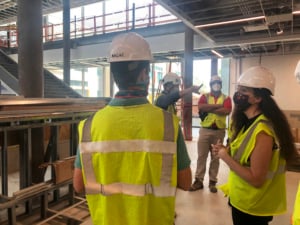Coping with COVID-19: Part IV, Impacts on Contracts

Over the last few weeks, we have been sharing updates through our Coping with COVID-19 in the Construction Industry series, doing our best to help you understand how COVID-19 is affecting the commercial construction industry, as well as how our COVID-19 Task Force expects the industry to shift and change as a result.
In our last post, we focused on the cost impacts of COVID-19. Today, we will be talking about contracts, as well as addressing some common questions on how contracts may be affected moving forward.
A subcontractor has walked off the job due to fears of COVID-19. As an owner, what are my options?
This has occurred on some projects that MGAC is involved in—deemed essential by the State—and in one case, without prompt notice. This leaves the general contractor in a tricky position with a contractual performance obligation, assuming all CDC and OHSA health measures are in place. For the subcontractor, it was understandably a difficult decision, as they were primarily concerned for the safety of their employees in a rapidly changing situation. However, for the owner, there are some safeguards. The contract is between the subcontractor and general contractor. An owner can assume that the general contractor’s contract with the subcontractor is going to work similarly to their own contract with the contractor; there will be performance requirements tied to an agreed-upon project schedule and staffing requirements to make that possible. Likewise, there is a termination option for the subcontractor’s non-performance. If the general contractor has the appropriate insurances, this should cover additional procurement costs and liquidated damages.
So far, MGAC’s recommendation has been to increase communication and ensure the general contractor updates the owner on a regular basis on the subcontractor’s voluntary suspension of work. By working as a collaborative team with the general contractor and subcontractor to satisfy onsite safety, you will ensure the delay is temporary and should be able to complete the project as close to on-schedule as possible. However, if the subcontractor’s self-imposed absence rises to a certain level that it presents a serious problem for the project and substitute contractors are unavailable, the owner and general contractor will likely have a discussion regarding potential legal ramifications.
A public authority has announced a state of emergency. What does this mean for my contract?
Largely speaking, this is one of the simpler questions. If the public authority having jurisdiction forcibly closes the site, then the contractor may stop work and potentially time and cost would be recoverable by the contractor if proven. That said, many contracts have clauses for allowing a contractor to terminate if a project is stopped for longer than 60 to 120 days, so owners may find themselves essentially needing to start again depending on the timeframe at hand.
Do I need to provide a future clause about pandemics?
Despite COVID-19, many projects are still moving forward, and contracts are getting signed now and will be 12 months from now, so what should owners look for in future contract negotiations?
You do not need to be a lawyer to understand that using boilerplate contracts containing a paragraph about force majeure with very limited specifics is not going to cut it moving forward. It may be sufficient dragging through a court of law, but this is a risk—and often, courts refuse to excuse performance unless the contingency is specifically listed. MGAC is advising owners to review and amend future contracts not only for pandemic verbiage, but also for other potential events (listed below). As part of this process, MGAC would also recommend assigning risk, schedule, and cost responsibilities to these events. No contract can adequately anticipate every possible event, but a pandemic, along with the additional events below, are now ones that will and should be explicitly included moving forward.
Below is a list of events to be included in 2020 and future contracts from the International Chamber of Commerce:
- Plague, epidemic, pandemic, outbreaks of infectious disease, or any other public health crisis, including quarantine or other employee restrictions;
- War (whether declared or not);
- Armed conflict (including, but not limited to hostile attack, blockade, military embargo);
- Invasion;
- Act of a foreign enemy;
- Extensive military mobilization;
- Civil war;
- Riot, rebellion, revolution, military or usurped power, insurrection;
- Civil commotion or disorder;
- Mob violence;
- Act of civil disobedience;
- Act of terrorism;
- Sabotage or piracy;
- Act of authority, whether lawful or unlawful;
- Compliance with any law or governmental order, rule, regulation, or direction;
- Curfew restriction;
- Expropriation or compulsory acquisition, requisition;
- Seizure of works;
- Nationalization;
- Act of God;
- Natural disaster, such as, but not limited to violent storm, cyclone, typhoon, hurricane, tornado, blizzard, earthquake, volcanic activity, landslide, tidal wave, tsunami, flood, damage or destruction by lightning, drought, explosion, and fire;
- Destruction of machines, equipment, factories;
- Prolonged breakdown of transport;
- Prolonged disconnect of telecommunication or electric current;
- General labor disturbance, such as, but not limited to boycott, strike and lock-out, go-slow, occupation of factories, and premises; and
- Shortage or inability to obtain critical material or supplies to the extent not subject to the reasonable control of the subject Party.
On our next and final installment of this series, we will discuss the impacts of COVID-19 on future planning.









